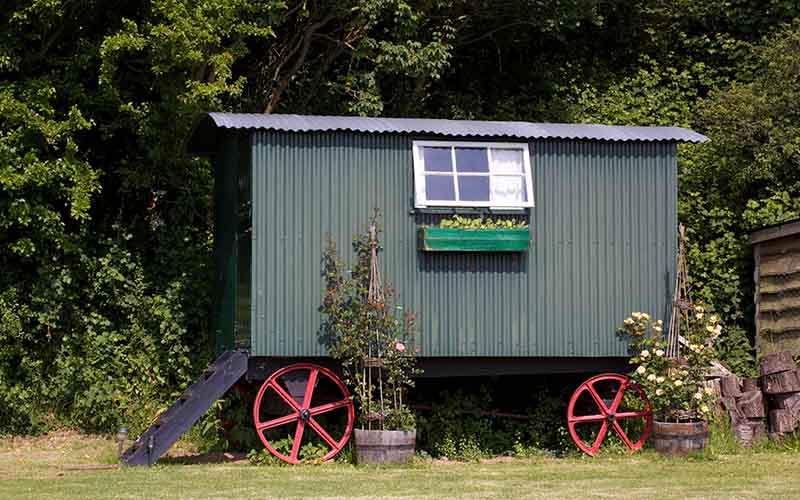The small house movement has become popular in recent years with people are feeling the need to downsize their living space to reduce environmental impact.
But what is considered a small house?
A small home will vary for different people depending on the size of their family, their living habits, and their financial abilities.
This article will discuss different factors that affect how big or small your home can be.
Table of Contents
What Is the Square Footage of a Small Home?
Since the median size of a single-family home in the United States is 1,600 square feet, a home under this size is considered small. Homes that are 900 to 1200 square feet are considered very small. Any home that is 400 square feet or less is known as a tiny home, or a micro-home.
Tiny homes are usually built on trailers for easy transportation and can be parked just about anywhere that there is room available.
Choosing a Small House Vs Tiny House

Many people believe that tiny homes are the same thing as small houses, but they actually have many differences.
Tiny homes are usually built on wheels for an easy move. These dwellings can be moved frequently or parked in one location if desired. They come as large as 400 square feet.
A tiny home can be as small as 100 square feet, but some are even smaller at just 80 square feet.
As far as zoning is concerned, tiny homes do not have to be built to the same building codes as standard homes.
They can be situated on the owner’s property, which gives them more freedom than they would otherwise have if living in a small home or apartment building.
Small homes are usually between 400 and 1600 square feet.
These dwellings tend to sit on properties that are at least one acre in size.
They are usually built on cement foundations, and they must be built to the specifications of local building codes.
Small houses tend to be traditional stand-alone constructions with permanent foundations and utility hookups (e.g. electricity, water, sewage).
They are also connected to the public sewer system rather than using outhouses or septic tanks.
Benefits of Small Homes
People often choose small homes because their low cost makes them affordable for young families or retirees who may not have a lot of money saved up.
These houses can also be more easily managed than larger ones that require hiring full-time help.
Since they are smaller, small homes don’t require as much energy to heat in the winter or cool down in the summer when it’s hot outside.
A small house can also have a positive impact on its surrounding environment because of its reduced carbon footprint.
Small houses tend to be more eco-friendly than larger ones due to less waste and less industrial pollution.
An average new house can produce up to 70,000 pounds of carbon dioxide emissions over its lifetime.
This is why small homes are so popular in many countries these days, as people work to reduce their environmental impact on future generations.
Small houses are also easier to maintain.
They require fewer repairs, are easier to clean, and landscaping may be more manageable depending on the outside area that the home is situated on.
Related: 12 Life-Changing Benefits of Living in a Small House
How To Choose The Right Size Home
Small homes are a great option for many people and you’ll want to ask yourself the following questions to decide if this is right for your family’s needs:
How Many Individuals Will Live In the Home?

The first question you should ask yourself is how many people will live in the home. If it’s just one person, the smallest house available may be sufficient.
Two people would need at least 500 square feet to feel comfortable. If you have children, you might need a bit more space.
Make sure to also plan for future tenants!
If you plan on having more children or may have roommates or family members come and live with you in the future, you may want to prepare for them.
What Is The Family’s Lifestyle?

You’ll also want to consider what type of lifestyle the family has if they are living in the home.
Are they large families who will experience a lot of activity?
A small house may not be able to handle so many people and their activities comfortably.
On the other hand, if you and your family are rarely home and often travel, you won’t need much space at all for the bare necessities of sleeping, eating, and showering.
How Do You Decorate Your Home?

If you have large amounts of furniture and lots of home décor, you may need more space.
Fixtures such as lamps and bookcases can take up a lot of space in smaller homes.
If you like homes that are filled with lots of décor and design, you may want to consider a larger home with more square footage.
However, for those who like minimal designs and are smart about their storage, a small home may be perfect.
You can also get a shed or a storage unit for those large, bulky items.
Do You Need More Outdoor Space?
Another factor that might influence which size of home you choose is outdoor space.
If your family loves to spend a lot of time outdoors in the yard or on the patio, having enough room for activities and amenities will be important so that everyone has their own personal space.
Small homes tend to have smaller yards, which can make it difficult if there is more than one person who wants to use the outdoor space at a time.
However, you could have a smaller home on a larger property, which would maximize your outdoor space.
Do You Work from Home?
If you work from home and want to live in a smaller house, you will need to carefully consider where the office will be located.
Space is limited, so you’ll need to find a way for your home office to fit into the small house without making it look too crowded.
How To Optimize Space in a Small Home
The spaciousness in a home is more a result of its design than its actual size.
Here are four helpful tips for getting started with making a small home feel larger:
- Create vertical storage systems: To maximize space in a smaller home, you’ll want to get creative and use every inch of the room that’s available. One option is creating vertical storage systems for your belongings that allow them to be stored out of the way until they are needed. These work great in kitchens, closets, and home offices. You can find DIY solutions or buy premade storage systems.
- Invest in multi-functional furniture: invest in pieces of furniture that can serve more than one purpose, such as a coffee table that also has storage for items inside. This will maximize the space you have by allowing furniture to double as storage, saving room on less-used pieces of furniture or cabinets.
- Spend time decluttering: If your home is full of clutter, it can make everything look smaller and more congested than it really is! Spend some time decluttering and organizing your belongings.
- Make sure the windows are large enough: Windows that look out into a beautiful landscape can make even the smallest homes seem much larger, so be sure you have ample window space in every room. Large windows will help brighten up a small house as well!
Final Thoughts
The size of your home can greatly influence how you feel doing day-to-day tasks.
It’s important to remember that even the smallest homes are typically designed in a way that makes them feel spacious and open, so there is no need to worry that they will box you in.
They’re also better for the environment, more affordable, and often have a unique charm that large generic houses don’t have.
Make your smaller home match your personality and it will accommodate everything you need!
Related guides:
